.
I've been published (again) !!
Look out for African Veins by Celliers Kruger
(playak review)
Celliers has included my Iran stories of paddling the Sezar and Bakhriaria rivers in the Zargros Mountains; the most amazing river trips of my life in the book he has put together of various river stories.
 The common link between all the stories are that they are by African paddlers (and I qualify as I was born and raised in Johannesberg and started my paddling career on the Vaal River).
The common link between all the stories are that they are by African paddlers (and I qualify as I was born and raised in Johannesberg and started my paddling career on the Vaal River).
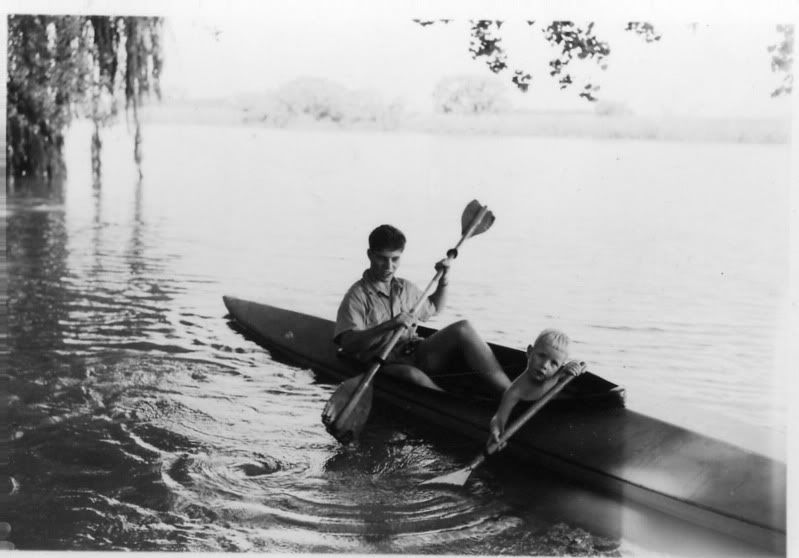
My introduction to kayaking in my cousin's kayak on the Vaal River.
It's not in British Shops yet but should be here soon through your Fluid Kayak dealer
You have missed the book promo tour but you can still buy Doug Ammons's Books from your local kayak store or if they have none left directly from his web site. See below for more about his books.
Doug Ammons.com
A bit about Doug's books
"White Water Philosophy" by Doug Ammons.
As Doug says in his introduction "This book was not planned but arrived in an unpredictable way as a result of my long time interest in flowing water and kayaking". As a result there is no real theme to the book but is a collection of Doug's musings to himself or kayak-magazine readers that he has written and is stronger for this; it gives you a wider insight to the man behind the keyboard. Though at the time of writing this promotion I have not read all the book, savouring it a bit at a time, what I have read is "up to standard": Doug's incredibly high standard at that. The book includes "Why I kayak", "Ode to the North Fork", "Niagara Falls and Crazy", "Soloing and taboos", "Voice of the River". It has no pictures as it is a book of thinking.
"The Laugh of the Water Nymph and other River Stories." By Doug Ammons.
Here's a revue I wrote of this book when it came out a couple of years ago.
Doug’s book arrived through the post the other day; delivered to me at work. We broke for breakfast/lunch and went down to the cafe for a traditional British fry-up. I tore into the book. I knew I shouldn’t but I couldn't stop myself; I wanted to find out what stories Doug had included. Trying to read the introduction and the chapter listings between mouthfuls was a bad idea - baked-bean sauce now stains the pages!
For many the name Doug Ammons will be unknown this side of the Atlantic and even over States-side he is not well known. Doug hails from Montana where he learnt to paddle and then used to drive crazy drives to the North Fork of the Payette in Idaho. There he met Rob Lesser and through Rob developed what can only be described as an unhealthy fixation with the Stikine, leading to Doug’s biggest “head game” paddle: his solo descent of the Grand Canyon of the Stikine. He is from the generation when “freestyle” was in its infancy, the term “Park and Play” had not been coined and the hottest move when playing was a “Polish Ender”. Doug won pretty well everything for a couple of those early years but exploring and river running was where he wanted to be.
The book is divided into three. In the first section - entitled “Horizon Lines” - the tales tell of learning, discovery and the joys of youthful naivety and enthusiasm. In this section is the eponymous “The Laugh of the Water Nymph”, a summer afternoon reverie half way through a relaxed river trip.
The second section, called “Other Truths”, is Doug’s musing on the state of the kayaking world. His satirical attack on the destruction of the soul of extreme sports by their commercialisation in “The Attack Of the Killer Radical Extremes” pulls no punches and is as subtle as a sledge hammer. The companion piece “The Tahiti Room” is the answer and through the introduction to the reader of the sport of underwater climbing in rivers tells how enjoyment of a sport can become a pursuit of dreams and then a dangerous single-minded fanaticism.
The final section of the book “Beyond Class V” details some of Doug’s major trips: trips to the Stikine and Aqua Azul and others but as you would expect these are not just accounts of how the trip went, with a list of the logistics and a few descriptions of the bigger rapids. Doug goes further and reveals to the reader his emotions, the ebb and flow of the trip giving you more than just a flavour of the exploit.
Sandwiched in the middle are 32 superb pages of colour photos from around the globe: British Columbia and the Stikine, Nepal and the Thule Beri, Mexico, Bolivia, and more
Doug has written the best book on white water - period. This is not a collection of tales of derring-do or reportage of epics had; it is Doug’s attempt to answer that question “why”. It is the nearest I am going to get a written reason why I paddle/have paddled hard white water. Even if it does not answer your questioning why you paddle white water it will give you a whole load of new questions to ask yourself on those lonely drives back from a weekend of river running. You know the drive: your mate is asleep, the radio is broadcasting only phone ins, the tape deck has a chewed tape in it / the CD player jumps / the ipod is out of battery or you just want quiet. Reflecting on Doug’s book will get you home awake!
Two testimonials for previous shows and talks:
“For twenty years Pipestone Mountaineering has hosted public presentations and slide shows by many of the top professional climbers, but I have to say, it’s a rare occasion to have a spellbinding presentation like Doug Ammons gave us. Doug’s gnarly river descents, the incredible photos, his insights about risk, and his psychological navigation transcend sport. The audience was speechless after the presentation. You could hear a pin drop - each person in deep thought from the visuals and commentary. Frankly, we were all astonished at the personal mental achievement of Doug’s descents, as well as his inner motivations for a life spent in the outdoors.
Doug’s presentation is a “must see” show that will leave you contemplating your life and the author’s. If you are an individual who steps into the outdoors, kayaks, hikes, or climbs, this show will light a fire in your heart.”
Jim Wilson, owner, Pipestone Mountaineering, Missoula, Montana
“Doug was the guest speaker at World Class Academy’s graduation ceremony in 2005, and immediately had an outstanding connection with the audience. He had a contagious enthusiasm, with thoughtful messages and humor. His kayaking career has been defined by pushing the limits of the possible, and he talks about the motivations and experiences in a passionate, inspirational way that anybody will find exciting. I’ve met very few people who care as much about kayaking and rivers as Doug. His enthusiasm, combined with his thoughtfulness about what makes rivers so beautiful and the world so inspiring, left everybody ready to jump into a kayak or head into the mountains.” Scott Dougherty. World Class Academy.
Doug Ammons’ shows in the United Kingdom, March 2009
The multimedia shows I will do in the UK will focus on the beauty and intensity of whitewater kayaking, travelling through a number of astonishing river landscapes around the world. In particular, we’ll head into the Grand Canyon of the Stikine River. The Stikine is one of the most difficult rivers ever done, hidden away in a deep canyon in the wilderness of northern Canada. The river casts an ominous shadow over anybody who decides to take it on. The instant you enter the canyon the rawness of the place shakes your core, shouting violence and danger. In an era where there are many professional, full time kayakers looking to make their mark, where skills and gear are astronomically advanced, this river stills kicks people’s asses. In 2006, of the four attempts by top teams, only one group made the descent.
The show talks about the unique lessons from rivers, and of the Grand Canyon of the Stikine as an exemplar of the edge. At the end of the show, I will talk a bit about one descent that means a great deal to me. In 1992, without telling anybody where what I was doing, I drove the 1700 miles north into Canada and soloed the Stikine. It has taken 16 years for me to decide to talk about my experience on that run, and I’ve never said anything publicly. It’s always dubious to compare across sports, but my good friend and partner Gerry Moffatt calls this solo “the equivalent of Reinhold Messner’s solo of Everest” and another partner, expedition paddler Charlie Munsey calls it, “one of the greatest feats in the history of kayaking”. I am not interested in the feat, but in where the journey takes us. Feats are in the past, but our real journey is always unfolding.
Rivers create some of the most beautiful and improbable landscapes on earth. Like many other people, I’ve been inspired by them for my entire life, and kayaking was just another vehicle for exploring them more intimately. I love the challenge, difficulty, and intensity of hard whitewater, but I also love the quiet serenity and flow of rivers. The following are a sampling of the kinds of ideas and images the shows will contain.
 The fabled North Fork of the Payette at super high flows
The fabled North Fork of the Payette at super high flows
At normal medium/low summer levels the river is one of the greatest continuous class V runs in the world. This is a photo from a mind-bending run when it was between four and five times that flow, cascading along at over 30 miles per hour with exploding waves and holes 10 to 12 feet deep. The usual 15 mile long run became essentially one continuous class VI rapid. You never fight with the water, because you’ll lose. Dealing with whitewater this fast and powerful requires a curious balance between hyper-awareness and complete relaxation. Photo Doug Ammons.
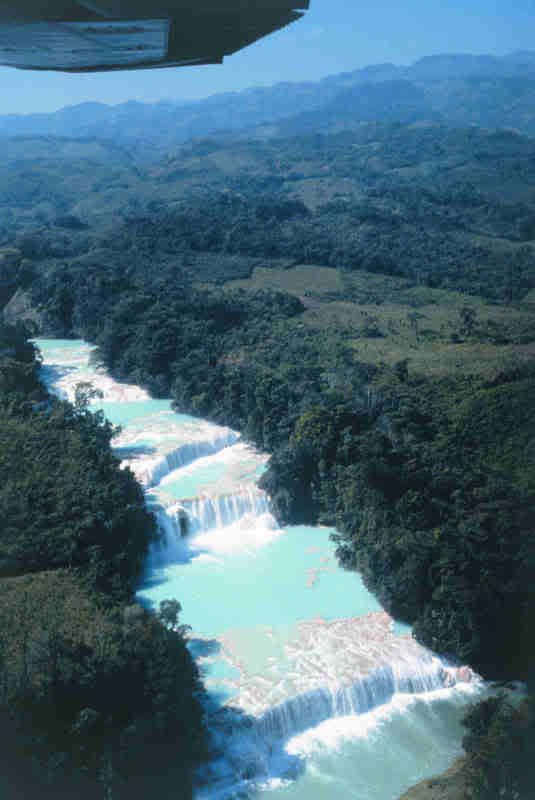
This is an aerial view of the famous “Agua Azul”, the huge set of travertine waterfalls on the Pashalaja river in Chiapas, southern Mexico, creating one of the most astonishing waterfall playgrounds imaginable. Photo: Bob McDougall.
 The Laugh of the Water Nymph
The Laugh of the Water Nymph
This is a brilliant shot my friend Nick Brown took of me running one of the larger falls at Agua Azul in southern Mexico. It’s a gift of our sport that our skills allow us to take part in the magic of flowing water and for brief moments, break free from the usual confines. This shot captures that instant. . Photo: Nick Brown see Doug Ammons.com
I did an expedition to southern Mexico to Agua Azul and its sister river, the Shumulha, making a film for National Geographic called “Jungle Kayakers” www.nationalgeographic.com/adventure/video/kayaking-mexico.html
The show turned out to be the most popular one they did for the entire decade of the 90s, and is still seen on international television. We descended the Shumula into a deep gorge and then followed it as it disappeared underground, to emerge nearly a mile away downstream out of the cave system. If you think whitewater above ground is complicated, then try running it 700 feet underground.
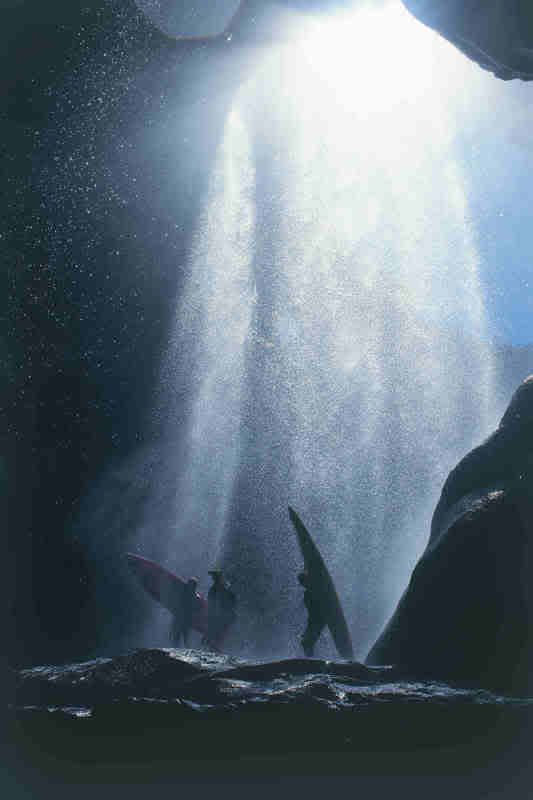 Cave paddling
This is a shot of us at the entrance to the cave. We are about 700 feet down into a narrow, vertical walled gorge, standing on top of a natural arch. Underneath us, the river crashes in a set of waterfalls into a final boiling pool before it disappears underground. There are places so improbable and beautiful that you cannot capture them; but you can experience them and the memories live on within you. Photo Markus Schmid.
Cave paddling
This is a shot of us at the entrance to the cave. We are about 700 feet down into a narrow, vertical walled gorge, standing on top of a natural arch. Underneath us, the river crashes in a set of waterfalls into a final boiling pool before it disappears underground. There are places so improbable and beautiful that you cannot capture them; but you can experience them and the memories live on within you. Photo Markus Schmid.
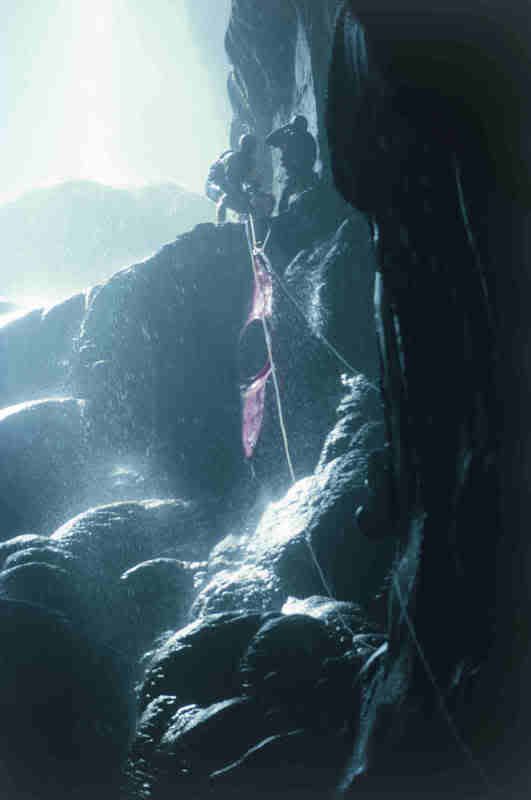 Here we’ve set up a fixed rope and are lining the kayaks across the absolutely deadly boiling pool where the water sucks underground in whirlpools. Team members were myself, Bob McDougall, Jerome Truran, Cully Erdman, Markus Schmid, and Scott Davis. Photo: Mike Brown
Here we’ve set up a fixed rope and are lining the kayaks across the absolutely deadly boiling pool where the water sucks underground in whirlpools. Team members were myself, Bob McDougall, Jerome Truran, Cully Erdman, Markus Schmid, and Scott Davis. Photo: Mike Brown
The Stikine
The following are a few shots from different runs of the Stikine. This is a place that is almost impossible to photograph because it is deep in a narrow canyon, the light usually sucks, and it’s raining much of the time. Further, the vertical walls and dangerous exposure means you can only shoot from a few places, and often have to rock climb to get to them. However, among us over the combined set of different runs, there are some dramatic images.
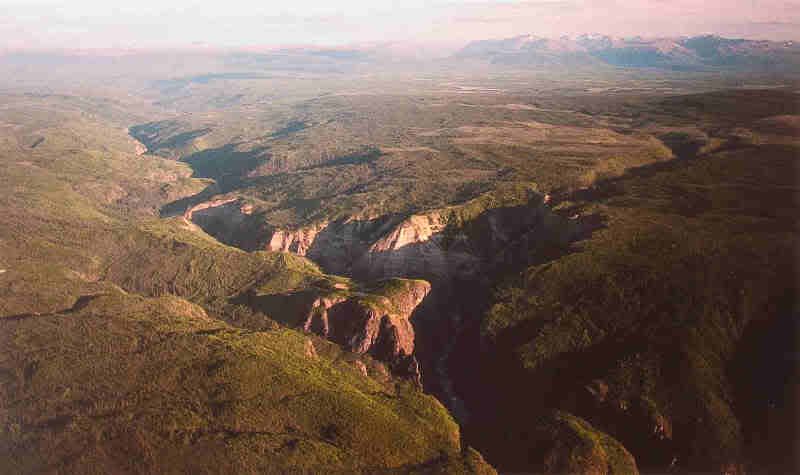 Stikine Aerial View
Stikine Aerial View
This is an aerial view of the canyon. It is over 1000 feet deep with rock walls rising directly out of huge rapids. The river is hidden and there is no place you can go to see what’s there - unless you have a helicopter and a very skilled, semi-insane pilot. Photo Doug Ammons
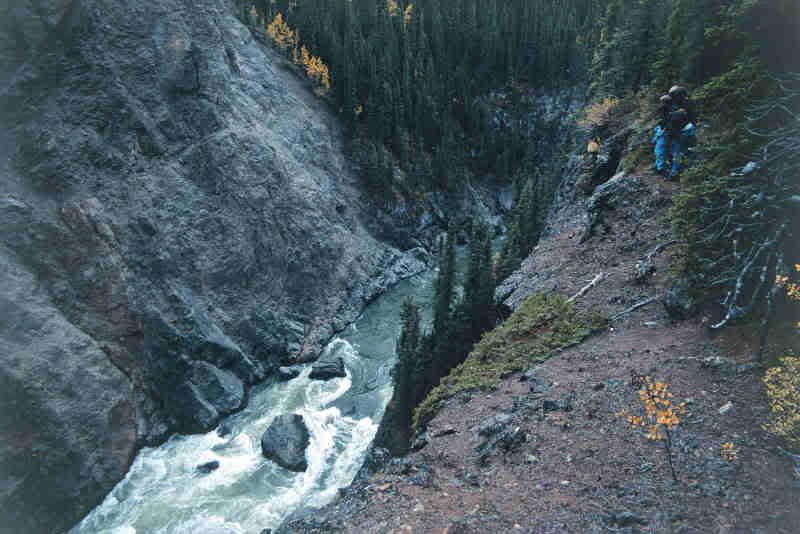 This is the first rapid of the Canyon, Entry falls, as seen from about 300 feet off the deck. Gerry Moffatt, Rob Lesser, and Charlie Munsey are scouting. One running jump and you’d be airborne until you landed in the middle of the rapid. Plenty of time for a flip or two. You can’t gauge the size of features or your line from so high above the water. Things that look simple are not simple. Features that look manageable will hammer you. If it looks white, it’s at least four times bigger than you think it is. On our first self-supported attempt in 1989, my close friend Bob McDougall got annihilated in a hole on the upper river right. After being pounded in the hole first in his boat and then out of his boat, he was stuffed up underneath a boulder against the wall. Blacking out, he clawed his way up to the surface and was spun into a little eddy. An epic ensued. We’ll talk about it in the show. Photo: Wink Jones
This is the first rapid of the Canyon, Entry falls, as seen from about 300 feet off the deck. Gerry Moffatt, Rob Lesser, and Charlie Munsey are scouting. One running jump and you’d be airborne until you landed in the middle of the rapid. Plenty of time for a flip or two. You can’t gauge the size of features or your line from so high above the water. Things that look simple are not simple. Features that look manageable will hammer you. If it looks white, it’s at least four times bigger than you think it is. On our first self-supported attempt in 1989, my close friend Bob McDougall got annihilated in a hole on the upper river right. After being pounded in the hole first in his boat and then out of his boat, he was stuffed up underneath a boulder against the wall. Blacking out, he clawed his way up to the surface and was spun into a little eddy. An epic ensued. We’ll talk about it in the show. Photo: Wink Jones
Around every corner you find another huge rapid. There are more than 25 named rapids, and at least 100 unnamed rapids. The names alone tweak the hardest core kayakers: Entry Falls, Wicked Wanda, Pass Fail, Wasson’s Hole, Site Zed, The Wall, Scissors, V-Drive. The rapids require a peculiar combination of finesse and power at breakneck speeds. Virtually every rapid involves weathering some heavyweight roundhouses, jabs and a haymaker, each one easily able to strip you out of your boat.
 Rob Lesser and me on the first self-contained descent, scouting at the bottom of a rapid we named “Pass Fail”. It is a grotesque exploding slalom course through huge boulders at the bottom. Around the corner below is another deadly rapid called Wasson’s Hole. The upper rock in the picture forms the line between passing and failing. If you get stuffed left of it, that’s the “fail”. Potentially, you’re dead. So the skizz is: get right and pass. Photo: Tom Schibig.
Rob Lesser and me on the first self-contained descent, scouting at the bottom of a rapid we named “Pass Fail”. It is a grotesque exploding slalom course through huge boulders at the bottom. Around the corner below is another deadly rapid called Wasson’s Hole. The upper rock in the picture forms the line between passing and failing. If you get stuffed left of it, that’s the “fail”. Potentially, you’re dead. So the skizz is: get right and pass. Photo: Tom Schibig.
 Rob Lesser submarining through a rapid called Powerhouse. The scale of the rapids in the canyon is incredible. This photo was taken at least 50 feet off the water, from about 50 yards upstream. Paddlers will understand that if something looks big from that perspective, then when you’re facing it down in the water in the pouring rain, it strips you of any feeling of bravado. In fact, instead of bravado, you realize how easily you can die. Photo: Wink Jones
Rob Lesser submarining through a rapid called Powerhouse. The scale of the rapids in the canyon is incredible. This photo was taken at least 50 feet off the water, from about 50 yards upstream. Paddlers will understand that if something looks big from that perspective, then when you’re facing it down in the water in the pouring rain, it strips you of any feeling of bravado. In fact, instead of bravado, you realize how easily you can die. Photo: Wink Jones
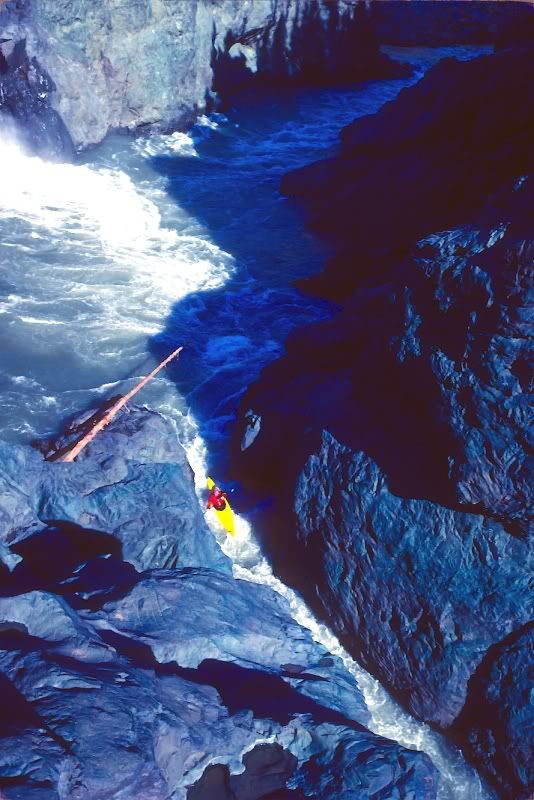 As dramatic as the main canyon is, the entire Stikine gets stuffed through a six foot wide slot at the Tanzilla narrows. Photo: Doug Ammons
As dramatic as the main canyon is, the entire Stikine gets stuffed through a six foot wide slot at the Tanzilla narrows. Photo: Doug Ammons
 3 of my kids. Sometimes the intense experiences, the beautiful places, the strong friendships seem to be the only answer we need. But as wonderful as rivers are, they are only a small part of a much bigger life. I’ve been married 25 years, have five children, a Ph.D., and a job running a business serving thousands of people. I’ve been supporting a school and a number of individual children in the poorest part of Nepal for the last 15 years. I believe in journeys that lead beyond the river. This photo shows three of my children, and they are who I live for – along with the rest of my family and the other people I love. Rivers have a sacred place, but never make the mistake of thinking that a sport is more important than the deeper responsibilities you have.
3 of my kids. Sometimes the intense experiences, the beautiful places, the strong friendships seem to be the only answer we need. But as wonderful as rivers are, they are only a small part of a much bigger life. I’ve been married 25 years, have five children, a Ph.D., and a job running a business serving thousands of people. I’ve been supporting a school and a number of individual children in the poorest part of Nepal for the last 15 years. I believe in journeys that lead beyond the river. This photo shows three of my children, and they are who I live for – along with the rest of my family and the other people I love. Rivers have a sacred place, but never make the mistake of thinking that a sport is more important than the deeper responsibilities you have.
A few thoughts:
Running rivers can be anything you want to make it. I guarantee it’ll be the most damn fun you ever had. Maybe you can brag about your feats, or you can laugh with your friends and partners, make the river into a party, joke about swimming out of a hole, enjoy the quiet, or just have the biggest smile on your face after a fantastic surf session.
Ultimately, how you use it and what you seek from it reflect who you are.
I treat places like the Stikine as a vision of my ideals. Certain places in this world are testaments to the wonder contained in flowing water. As grand gestures of nature. The Stikine is one of those. I am inspired by its power and beauty. I accept that I’m smaller than it is, and don’t consider myself greater for having done it. Neither I nor anybody else has changed it in the smallest way by running the rapids in there; the only possible thing that can be changed is what’s within us.
In the martial arts I’ve practiced for much of my life, the goal is not to learn a thousand ways to kill somebody and then consider yourself better and tougher. It is to turn the testing inward, realizing the hardest challenges are to your ego and self-understanding. The path to ego is short and easy. The path to self knowledge is endless and difficult. Kayaking is another form of martial art, but instead of fighting with another human, you learn to take part in the flowing power of the planet. That is a dramatic and mind-altering path, and it is right there, waiting for you the instant you push off the bank.
***************
Here is a sample of Doug’s writing, from a story called “A reminder” about a hair-raising accident on a flood stage river: see: www.dougammons.com for the full story and other companion stories.
When you head into a huge rapid, there's always this sense of disbelief. If it's really a big rapid, the river drops off the face of the earth; all you see is a horizonline of humped up dark water, and you feel like you're like revving your car straight for the edge of a cliff. You come up on it and the whole rapid is somewhere on the other side, unseen, crashing away below. All the power of the world seethes beneath you. You feel it welling up and accelerating, pulling at you like a bronco in the stall, muscles tensing, ready for the gate to open. The bronc's will is to break away and not be chained, to fight every limitation and barrier and kick and snort and go like a hellion any way it can. A bad bronc might have some bad attitude toward you, he might feel those spurs and think and wait and set you up, and then do you. But this bronc is liquid and weighs thousands of tons and doesn't think and doesn't care. So you hang on the expectancy as you paddle toward that horizonline. Then, you slip over it, the bronc's cut loose and you're out of the gate….
… The metallic taste fills my mouth and I sweep a third time and there's another explosion of bright pain. I'm not mad, not frustrated, not scared, I'm just thinking, Make the move. But the water is flushing me way left, and I'm bearing down on the corner and suddenly, I know I can't make it. I glance and see a big curling wave on the crest of the ramp above the Dome Hole and know I've got one chance to take a stoke and catch the wave enough to surf a little back to the right, away from the gut of the hole. I’ve got maybe a second watching it coming and setting my backstroke, then I'm swept up on the wave and it breaks down on me and I stroke and - nothing happens. My right arm doesn't work; it's paralyzed. I'm willing it to work, but my neck and shoulder and arm just scream back at me with another explosion of pain. Time freezes, then the curling wave lifts me up, spins the boat effortlessly, and flushes me backwards down the ramp into the biggest hole on the river. And I'm calm, so calm, just looking up into the blue sky and all I can think is, I'm in for it now.
I hit the bottom, and the water drives me down and the huge, flushing plunger of the river cartwheels the boat end-for-end like a kid's toy. I can feel the boat airborne and I twist it strong, cranking my body to the left as the boat flies out and twists to land upright, and for an instant I'm balanced, then I'm sucked back down into the gut of the thing and feel it driving me deep, and then the boat surges out of the water, rising and airborne in another cartwheel and I hang my weight back and twist and drive the boat with my knees as it flips through the air. I land up high on the backwash, I can feel I’m way up near the balance point on the crest and I know this is it. I dig my paddle deep into the bursting water and pull. I pull and pull with my bad arm as the hole yanks and rips my paddle and that grating bone pain explodes in lights flashing through my body. Waves of nausea flush through me, and my arm and back are locked up and I can’t move them but I keep pulling and pulling with everything I have.
And then I wash free….”
*************************************************************************************************
Dudh Kosi - Relentless River of Everest.
At last the original Award-winning HTV film has been released on DVD!
Read more and buy it here
The Coruh Extreme Races were white-water events I was running out in Turkey
I'm not carrying on with these at the minute but if you're interested then please
let me know
Many Rivers to Run is a book of kayaking stories I have compiled
The book is available for £16. See more details about it and read some reviews
here
'If the stories aren’t enough to set the heart racing then the few black-and-white
and superb sections of colour photos will help. This book is far and away the best
and most enjoyable collection of “paddling stories” that I have read. An inspirational
read.' Chris Sladden reviewing Many Rivers to Run